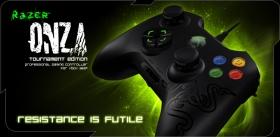
In terms of ergonomics, the design is largely similar to the first-party solution, though it is a little lighter and the build feels a little cheaper. I was given the Tournament Edition Onza to check out, and although I can't attest to the performance of the standard version's thumbsticks, sans adjustable resistance system, I can speak to the quality of just about everything else. There are two different Onza models, the base version, which forgoes the adjustable thumbstick tension mechanisms and LED backlighting in exchange for a $10 discount off of the full-featured Tournament Edition, which retails for $49.99.

While the design is based largely on Microsoft's first-party controller, it tweaks some elements of the original and adds a number of new features of its own, specifically a second set of shoulder buttons, which can be digitally mapped to perform the function of any other button, manually adjustable tension mechanisms on the thumbsticks, low-profile, hyper-responsive action buttons, and a d-pad that blends the form of the Xbox 360 controller's with the four-button configuration of the PlayStation 3's. The Onza is Razer's first foray into console controllers, and a project that has been in the works for over a year. The honeymoon isn't over, but our fiery romance has lost some of its luster.īut first, a quick recap for those just joining us. While my original assessment stands it is an awesome controller I have since found a few notable, albeit minor, issues. When I first received Razer's long-awaited Onza controller for the Xbox 360 earlier this month, I was taken with the design praising its unique approach to d-pad design, digital button remapping, and its responsive action buttons.


 0 kommentar(er)
0 kommentar(er)
